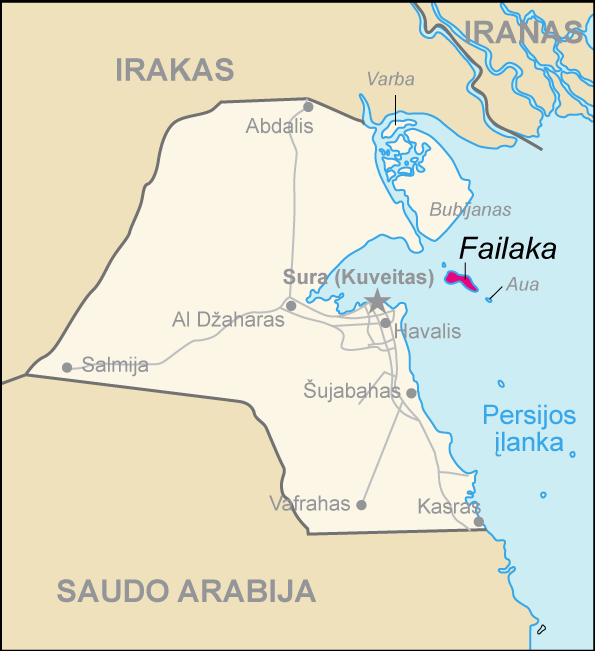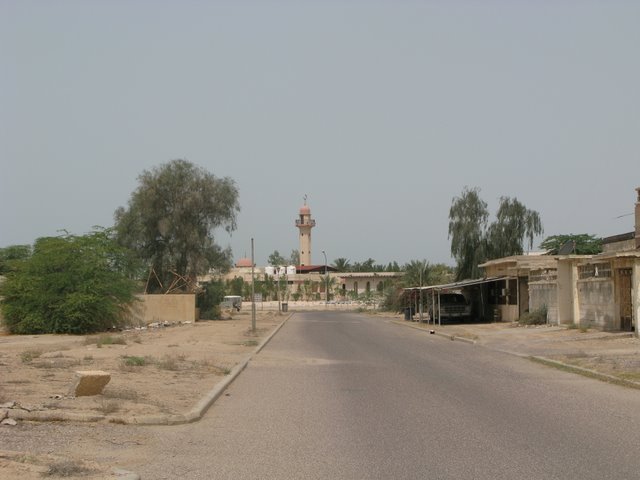Failaka Island
| The below content is licensed according to Creative Commons Attribution-ShareAlike License contrary to the public domain logo at the foot of the page. It originally appeared on http://en.wikipedia.org. The original article might still be accessible here. You may be able to find a list of the article's previous contributors on the talk page. |
Failaka Island (جزيرة فيلكا jazīrat Faylakah / Fēlaka) is an island that belongs to Kuwait in the Persian Gulf. The island is 20 km off the coast of Kuwait City in the Persian Gulf. The name "Failaka" is thought to be derived from the ancient Greek φυλάκιο(ν) - fylakio(n) "outpost".[1]
History
During the Dilmun era (from ca. 3000 BC), which saw the establishment of neighboring Bahrain, the island of Failaka was already developing its own unique culture and religious pantheon. Failaka was settled after 2000 BC following a drop in sea level.[2] Worship of the sun appears to have been practiced (see Shamash). Human sacrifice may also have taken place.
At some point following Alexander the Great's initial advance through the region in 331 BC or in the period 324/3 BC when he returned to Mesopotamia, the ancient Greeks colonized the island, which they named Ikaros after the Greek island in the Aegean Sea and the mythical hero Icarus, apparently in the belief that the island had a similar shape of its Aegean counterpart. Some elements of Greek mythology were mixed with the local cults.[3]
The island was inhabited through to the seventh or eighth century AD. It is unknown when the island was resettled in modern times.
Prior to the Iraqi Invasion, the island had over two thousand residents and several schools. The village of Az Zawr is situated near the middle of the northwest side of the island. It was the longest continuously inhabited location in Kuwait. During 1990 and 1991, the invading Iraqis depopulated the island, expelling all of its residents to the mainland. The Iraqi military mined the beaches and used the island's facilities and buildings for target practice. In 1991, the allied forces forced the Iraqi army forces occupying the island to surrender through bombing and psywar operations.[4] The sewage system was destroyed and has yet to be fully repaired. Also, many old homes continue to sit empty and decaying; bullet holes can still be seen.
After the war, Failaka was cleared of mines, but it remains under military use. Nevertheless, Failaka Island is becoming a popular holiday destination from Kuwait City. The ferry Ikarus takes passengers out to the island.
Several of the captives held in extrajudicial detention in Guantanamo faced the allegation that their name had been found on a list recovered from a hard drive of a computer of an al Qaeda terrorist suspected of involvement with an October 2002 attack on US Marines stationed on Faylaka Island.[5][6][7][8][9] The Marines were training with blank ammunition when two terrorists drove by and fired AK47 rifles, killing one Marine and wounding another. Several Marines responded by killing the two attackers with pistols that were on hand for security.[10]
Climate, geography and the future
Failaka Island is located in the northern part of the Persian Gulf. Springtime on Failaka Island is regarded as particularly special by Kuwaitis. Failaka has quite a different ecosystem to mainland Kuwait, and its budding flowers and changing temperatures are much appreciated. Although the island's infrastructure remains poor, Failaka is beginning to develop a local tourist industry; it provides fishing, boating, swimming, sailing and water sports.
The few remaining local residents are mostly those Failakawans who lived with their families on the island prior to the Iraqi Invasion of 1990. Most Failakawans have their own boats and some are involved in tourism, but many are reticent about letting tourism detract from the quiet island life. Some Failakawan families, although now living in mainland Kuwait, regularly go to the island on weekends.
On the mainland, in Kuwait city, there have been various schemes to build a bridge to the island and make it a vacation paradise, as has been done in Bahrain.
The museum and archaeological sites (the Ikarus and Azuk temple sites) are planned to re-open. In July 2007, Kuwait and Greece signed an agreement allowing Greek archaeologists to continue their work on the island[3] under the aegis of Angeliki Kottaridou and Panagiotis Hadzidakis. Other sporadic archaeological work has restarted on the island, with the discovery of 18th-century Portuguese, and later British, fortifications. A new hotel resort has encouraged many of the improvements.
Notes
- ↑ BBC News article
- ↑ Potts, Daniel T.. Mesopotamian civilization: the material foundations. 1997
- ↑ 3.0 3.1 Αρχαιολογία: Ελληνες στο Κουβέιτ Template:Gr icon
- ↑ "US psy-ops play it loud". BBC News. 2003-03-17. http://news.bbc.co.uk/2/hi/middle_east/2855269.stm. Retrieved 2010-05-02.
- ↑ OARDEC (2005-05-19). "Unclassified Summary of Evidence for Administrative Review Board in the case of Al Bahooth, Salih bin Muhammad". United States Department of Defense. pp. pages 38–40. http://www.dod.mil/pubs/foi/detainees/csrt_arb/ARB_Round_1_Factors_001046-001160.pdf#38-40. Retrieved 2008-11-21.
- ↑ OARDEC (2005-04-06). "Unclassified Summary of Evidence for Administrative Review Board in the case of Al Umari, Musa Ali Said Al Said". United States Department of Defense. pp. pages 69–71. http://www.dod.mil/pubs/foi/detainees/csrt_arb/ARB_Round_1_Factors_001046-001160.pdf#69. Retrieved 2007-12-07.
- ↑ OARDEC (2004-11-16). "Summary of Evidence for Combatant Status Review Tribunal --". United States Department of Defense. pp. pages 80–81. http://www.dod.mil/pubs/foi/detainees/april_CSRT_FOIArelease4.pdf#80. Retrieved 2008-11-21. mirror
- ↑ OARDEC (28 September 2004). "Summary of Evidence for Combatant Status Review Tribunal -- Al Umari, Musa Ali Said Al Said". United States Department of Defense. pp. page 8. http://www.dod.mil/pubs/foi/detainees/csrt_arb/000201-000299.pdf#8. Retrieved 2007-12-07.
- ↑ OARDEC (2005-04-28). "Unclassified Summary of Evidence for Administrative Review Board in the case of Al Kandari, Faiz Muhammed Ahmed". United States Department of Defense. pp. pages 31–33. http://www.dod.mil/pubs/foi/Reading_Room/Detainee_Related/ARB_Round_1_Factors_001161-001234.pdf#31. Retrieved 2009-07-31.
- ↑ Schmitt, Eric (2002-10-09). "U.S. Marine Is Killed in Kuwait As Gunmen Strike Training Site". New York Times. http://www.nytimes.com/2002/10/09/world/threats-responses-skirmish-us-marine-killed-kuwait-gunmen-strike-training-site.html. Retrieved 2009-07-31.
Further reading
Hellenistic Failaka
- H.E. Mathiesen et al., Ikaros: The Hellenistic Settlements, 4 vols. (Copenhagen, 1982-1989).
- C. Roueché and S. Sherwin-White, ‘Some aspects of the Seleucid Empire: The Greek inscriptions from Failaka in the Persian Gulf’ Chiron 15 (1985) 1-39.
- J. Naveh, 'The inscriptions from Failaka and the lapidary Aramaic script' Bulletin of the American Schools of Oriental Research 297 (1995) 1-4.


